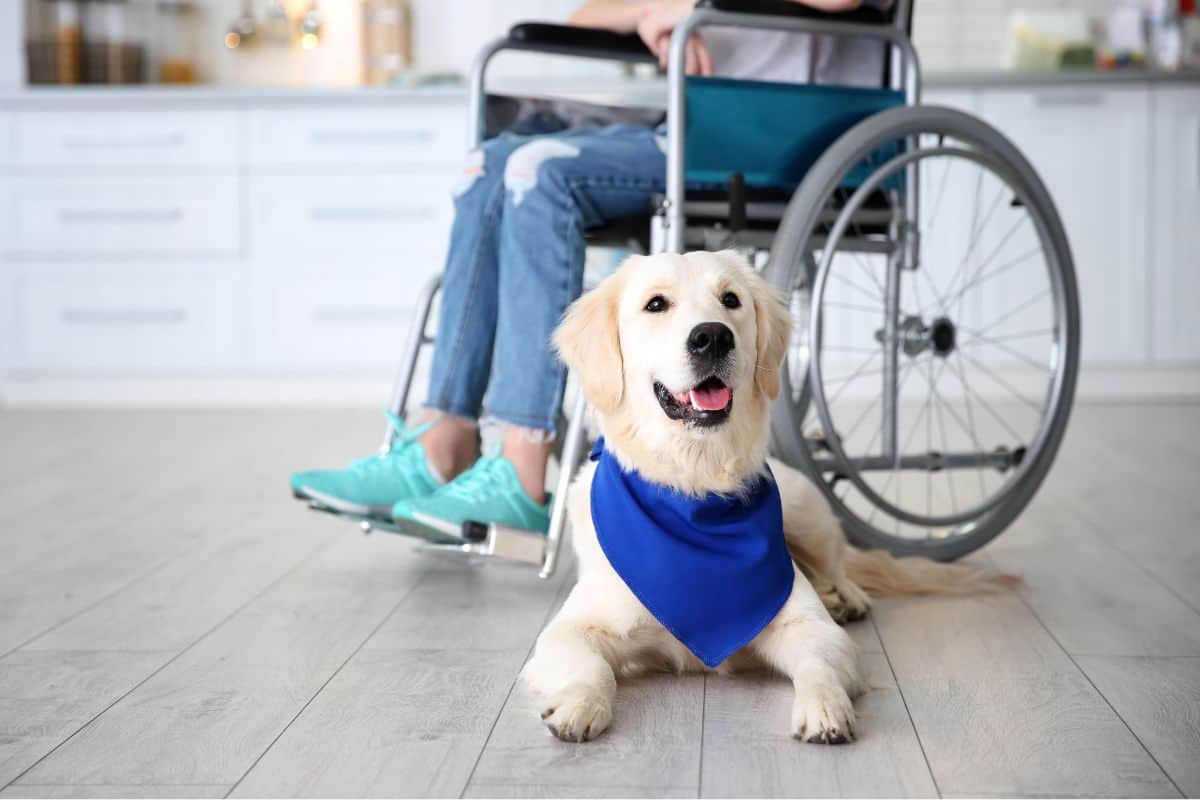How to Make Your Dog a Service Dog: An Expert Guide

Do you dream of making your loyal canine companion a service dog, providing invaluable support to someone in need? The journey of transforming your dog into a service dog is both rewarding and impactful. In this comprehensive guide, we'll explore every step on the path to creating a service dog. From assessing your dog's suitability to legal requirements, training techniques, and even handling public access, we've got you covered.
Understanding Service Dogs
Service dogs are not just pets; they're highly trained working dogs that assist individuals with disabilities. These incredible animals can perform a variety of tasks, from guiding the visually impaired to alerting those with medical conditions. To begin your journey to create a service dog, it's essential to grasp the fundamental concepts:
Service dogs come in various forms:
- Guide Dogs for the visually impaired.
- Hearing Dogs for those with hearing impairments.
- Mobility Assistance Dogs for people with physical disabilities.
- Medical Alert Dogs for conditions like diabetes or seizures.
Consult with healthcare providers, such as your primary care physician or mental health specialist, to determine if a service dog could significantly improve your quality of life.
Assessing Your Dog's Suitability
The first step on this remarkable journey is assessing whether your dog possesses the necessary qualities to become a service dog. While any breed can potentially be trained, certain traits are crucial:
- Temperament: Service dogs must be calm, confident, and unflappable. They should remain composed even in stressful situations.
- Trainability: A service dog should be eager to learn and responsive to training cues. Basic obedience skills are a must.
- Health: Your dog should be in excellent physical health, free from debilitating conditions.
- Age: While there's no strict age limit, most dogs begin service dog training in puppyhood.
- Socialization: Early socialization is essential. Exposure to various environments, people, and animals will help your dog adapt to different situations.
- Non-aggressiveness: A service dog cannot be aggressive towards people or other animals.
If your dog checks these boxes, you're on the right track. However, assessing your dog's suitability is just the beginning.
Professional Training vs. Owner Training
Now that you've evaluated your dog's potential, you might wonder whether to opt for professional training or take on the task yourself. Let's explore both options:
Professional Training
Benefits:
- Expertise: Professional trainers are experienced in service dog training.
- Faster Progress: Training is typically quicker with experts.
- Certification: A professionally trained service dog often comes with recognized certification.
Challenges:
- Cost: Professional training can be expensive.
- Limited Bond: You might have a less personal relationship with your dog.
Owner Training
Benefits:
- Bond Building: Training your dog personally strengthens your bond.
- Cost-effective: It can be more budget-friendly.
- Customization: You can tailor training to specific needs.
Challenges:
- Time-Consuming: Training requires dedication and patience.
- Responsibility: The onus is on you to ensure your dog meets the required standards.
Whether you choose professional training or opt for owner training, the goal remains the same: a well-trained and reliable service dog.
Owner Training Steps
If you decide to take on the responsibility of owner training, here are the essential steps to follow:
Step 1: Identify Specific Tasks
Determine the specific tasks your service dog will need to perform. These tasks should directly assist the individual with a disability. For example, a medical alert dog may need to detect changes in blood sugar levels.
Step 2: Basic Obedience Training
Solidify your dog's basic obedience skills. This includes cues like sit, stay, come, and heel. A strong foundation in obedience is crucial for advanced training.
Step 3: Advanced Task-Specific Training
Once basic obedience is mastered, move on to task-specific training. For example, if your dog is assisting someone with mobility issues, train them to retrieve objects or open doors.
Step 4: Public Access Training
Teach your dog how to behave in public spaces. This includes being calm, non-disruptive, and responsive to your cues. Proper behavior in public is essential.
Step 5: Socialization
Expose your dog to various environments, people, and situations. This helps your dog become confident and adaptable. Remember, a well-socialized dog is more effective as a service dog.
If you opt to train your own service dog, you should look into dog training schools, like The Academy of pet careers, that can teach you how to train service dogs. The cost for education can be less than the cost to obtain a trained service animal.
Legal Requirements and Documentation
Understanding the legal requirements for service dogs is paramount. In the United States, the Americans with Disabilities Act (ADA) provides specific guidelines:
- Definition: According to the ADA, a service animal is a dog that is individually trained to do work or perform tasks for a person with a disability.
- Rights: Service dogs have the right to accompany their owners in places where the general public is allowed, including restaurants, stores, and public transportation.
- Documentation: While not required by law, it's helpful to have documentation from a healthcare professional or a service dog certification organization.
- Certification: The ADA does not mandate certification, but some organizations, such as The Academy of Pet Careers, offer recognized certification programs.
Remember to research and understand the laws and regulations in your specific location, as they can vary.
Handling Public Access and Etiquette
Once your dog is trained, you'll need to navigate public spaces and ensure your dog behaves appropriately. Here are some tips:
- Access Rights: Know your rights regarding public access. Service dogs are allowed in most public places, but they must be well-behaved.
- Leash and Harness: Keep your service dog on a leash or harness unless doing so interferes with their tasks. This provides better control in public.
- Behavior: Your dog should remain calm and non-disruptive in public places. Avoid excessive barking or jumping.
- Public Interaction: Educate others about service dogs. While people may approach to admire or pet your dog, they should ask for your permission first.
- Cleanliness: Ensure your dog is clean and well-groomed when entering public spaces.
By following these guidelines, you can ensure your service dog is a model of good behavior in public.
Health and Wellness of Your Service Dog
The well-being of your service dog is of utmost importance. Regular veterinary care is essential to maintain their health. Here's what you should keep in mind:
- Health Check-ups: Schedule regular check-ups with your veterinarian. This helps identify and address health issues promptly.
- Diet and Exercise: Feed your service dog a balanced diet and ensure they get regular exercise. A healthy body supports their ability to perform tasks effectively.
- Mental Stimulation: Mental stimulation is as crucial as physical exercise. Engage your dog in activities that challenge their mind.
- Rest: Ensure your dog gets adequate rest. Fatigue can hinder their ability to assist effectively.
- Hydration: Always provide access to clean water to keep your dog properly hydrated.
Continuous Training and Evaluation
The training journey doesn't end once your dog becomes a service dog. Continuous training and evaluation are essential to maintain their skills and ensure they perform their tasks reliably. Here's how to approach it:
- Regular Practice: Continue practicing obedience and task-specific skills regularly.
- Periodic Evaluation: Consider having your dog evaluated by a professional trainer that specializes in service dog training.
- Adapt to Changing Needs: As the needs of the individual with a disability evolve, adapt your dog's training accordingly.
By investing in ongoing training and evaluation, you'll ensure your service dog remains a valuable asset to those they assist.
Resources and Support
Creating a service dog is a journey that requires support and access to resources. Here are some valuable resources:
- The Academy of Pet Careers: Our organization offers programs for people to learn how to train service dogs or to become a service dog trainer. Their expertise can be invaluable on this journey.
- Local Dog Trainers: Consider enlisting the help of local dog trainers who specialize in service dog training.
- Online Communities: Join online forums and communities where service dog owners share tips and experiences.
- Legal Resources: Familiarize yourself with the legal rights and regulations pertaining to service dogs in your area.
- Service Dog Organizations: Connect with organizations that support service dog owners. They often offer guidance and resources.
Creating a service dog is a remarkable journey that requires dedication, training, and a commitment to helping others. Whether you choose professional training or take on the responsibility yourself, remember that service dogs can transform lives. By following the steps outlined in this guide and seeking support from resources like The Academy of Pet Careers, you'll be well on your way to creating a service dog that makes a profound difference in the world.
Frequently Asked Questions
Service dogs are trained to perform specific tasks to assist individuals with disabilities. Therapy dogs provide emotional support to individuals in hospitals, schools, or therapy sessions but are not trained for specific tasks. Learn more about the differences between service dogs and therapy dogs.
While any breed can potentially become a service dog, they must possess the right temperament, trainability, and health. Certain breeds are more commonly used due to their characteristics.
Training duration varies but typically takes around 1 to 2 years, with ongoing training throughout the dog's life.
It's possible to train your dog yourself, but professional trainers can expedite the process and ensure higher success rates.
While not legally required, documentation from a healthcare professional or a recognized certification organization can be helpful.
 Author - Joseph Schifano
Author - Joseph Schifano
Joseph Schifano is the owner and President of The Academy of Pet Careers. With over 20 years of experience working in the pet field, managing large scale pet care businesses, he has experience in every facet of the industry. Joseph's focus is primarily on the business of pet care but his passion is in understanding animal behavior how a dog's brain works so we can improve the care we provide as pet professionals. He is a huge advocate for Pet Empowerment and Force Free training methods. Read more in Joseph's full bio.
